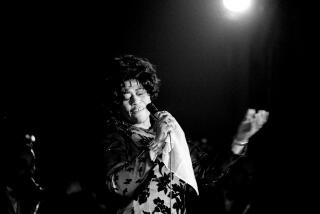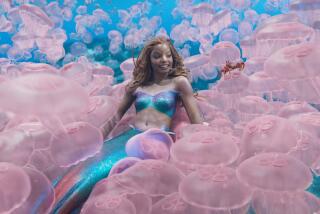HOME ENTERTAINMENT : Laser Version of ‘My Fair Lady’ a Bloomin’ Triumph
- Share via
If you are an Audrey Hepburn fan and own a laser player, you’ll find a bonanza awaiting you at the video store: a sumptuous “My Fair Lady” in a “30th Anniversary Restoration Widescreen Collector’s Edition,” from Fox Video/CBS Video/Image Entertainment ($130), and a collector’s “Breakfast at Tiffany’s” edition from Paramount Home Video ($80; the disc is also available singly for $40).
It doesn’t matter how many times you have seen “My Fair Lady” on television or on videotape, nothing quite prepares you for seeing the restored “My Fair Lady.” If you didn’t see this glorious Lerner and Loewe musical when it was first released in theaters in 1964 or catch it on the big screen when re-released in its restored form this year, this is your chance to see what all the fuss was about.
This edition, like its VHS counterpart, comes with more special, even gimmicky “collector’s” items than one would think possible: limited-edition reproductions of Cecil Beaton’s Oscar-winning costumes; a clip of six frames from the original Super Panavision 70 print; a special printing of Beaton’s “Fair Lady” diary; a 24-karat gold CD of the classic score.
Of more value is a promotional documentary, “More Loverly Than Ever: The Making of My Fair Lady. Then and Now.” A full-color brochure features well-annotated notes and complete chapter stops.
But for Hepburn fans, the real bonus is watching her sing two numbers that she recorded herself. Her vocals weren’t used in the film because singer Marni Nixon was called in to record the complete soundtrack. Nixon did a superb job of capturing in music what Hepburn was doing on screen. Hepburn, however, insisted on doing “Wouldn’t It Be Loverly?” and “Show Me” herself because she felt her voice could handle the songs and it would give more credibility and realism to her character.
When it was finally decided to use Nixon’s versions of even these two songs, Hepburn, furious, walked off the set, only to return later with an apology. Not singing the role in the film, however, was one of the great disappointments of her life.
Laser technology now enables you to zip back and forth between Hepburn’s voice and Nixon’s voice as the restored scenes unfold. The footage of Hepburn singing the staged numbers of both tunes can be seen on both the “Making of . . .” documentary and in CAV on a supplemental sixth side. Although Hepburn does a respectable job on both numbers, one can see how the purity of Nixon’s voice tipped the studio’s decision. What is amazing is how much Nixon succeeded in sounding like Hepburn’s natural voice while enhancing its upper registers.
When all the bonuses are finally tucked away, it is the wonderful, restored film itself that overwhelms in an incredibly sharp transfer with THX sound and razor-sharp THX picture that is only suggested on the new VHS videotape collector’s edition.
Hepburn, who was maligned at the time for replacing Julie Andrews, gives one of her finest performances--she is the perfect Eliza (with a big assist from Nixon).
No one could play Prof. Henry Higgins but Rex Harrison, for whom the role was first envisaged by Lerner and Loewe. As the documentary reveals, when Cary Grant was asked about taking over the role, he told studio head Jack Warner, “Unless you cast Rex Harrison and Stanley Holloway (as Alfred Doolittle), I’ll never make a film for Warner Bros. again.” Harrison won an Oscar for the role.
If there is an Academy Award for saving films, restorers Robert A. Harris and James C. Katz certainly are deserving of one for preserving for all time this masterpiece of a musical. A special collector’s section in the laser edition shows just what was almost lost.
Hepburn’s 1961 “Breakfast at Tiffany’s” has been digitally remastered in its original widescreen format. The collector’s edition includes a copy of Hepburn’s hand-notated script; a CD of Henry Mancini’s score featuring the Oscar-winning “Moon River”; three 8-by-10 glossies; a brochure reproducing notes from Hepburn to Mancini and a remembrance by Mancini; and the theatrical trailer.
What is not included, however, is what could readily set it apart from its VHS counterpart: an analog soundtrack from director Blake Edwards and others offering real information and details about the making of the film.
It’s such a grand-looking package that it’s a shame the producers missed another golden opportunity to use laser technology to enhance the motion picture experience.
More to Read
The biggest entertainment stories
Get our big stories about Hollywood, film, television, music, arts, culture and more right in your inbox as soon as they publish.
You may occasionally receive promotional content from the Los Angeles Times.










